
Zalau
Encyclopedia
Zalău is the seat of Sălaj County
, Transylvania, Romania
. In 2004, its estimated population was 62,900.
", 8 kilometers away from the historical landmark of Porolissum
, a well-preserved Roman Castrum
with an imposing fortress, an amphitheater, temples, houses and a customs house in the ancient Roman province
of Dacia
. Zalău was the crossing point between Central Europe and Transylvania
, along the so-called "Salt Route".
Archaeological discoveries revealed evidence of human existence in this area since the Neolithic
, approx. 6500 years ago. Dacian coins found in archaeological perimeters of the city central area and on the Valea Mâții, west of the city, plus important items belonging to Roman culture, are evidence of free Dacian continuity in this area and of developing economic relations with the Roman ancient city of Porolissum.
After the conquest of Dacia by Trajan
(106), the Roman Empire
border stood atop the Meses Mountains, just 5 Km away from the city. Just north from the border, on the actual Zalău city area were the free Dacians tribes, and to the east, south-east (of Meses Mountains) were Roman border fortifications, towers, walls, ditches and defense sides.
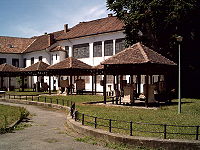
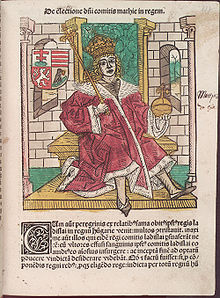
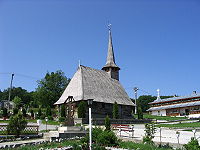

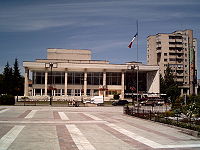
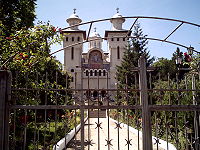
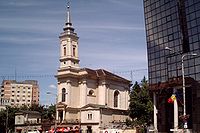
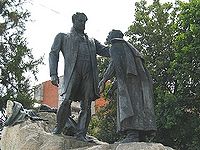
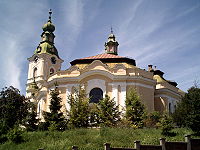

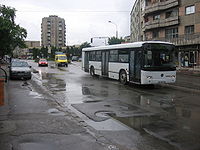

", also called the "Chronicle of Anonymous" (probably notary of the King Béla III
of Hungary
), published around year 1200. According to this source, Zalău settlement would have been there as early as around 900. Later, Zalău is referred to as Villa Ziloc in 1220, Zylac in 1246, Zylah in 1282, Zyloh and oppidum Zylah in 1318, Zila in 1601, Zilahu in 1808, Sziláj / Szilágyi in 1839, Szilaju in 1850, and Zalău / Sziláju / Walthenberg in 1854.
After the great Mongol invasion, which destroyed the city in 1241, Zalău came in 1246 under the administration of the Catholic Bishopric of Oradea
. The trusteeship was maintained until 1542, when Zalău became part of Principality of Transylvania.
On August 1, 1473 Matthias Corvinus, king of Hungary
and Bohemia
, acknowledged Zalău as a market town for the first time (called oppidum
Zilah - Zilah fort), a privilege that freed the city from the county domination, granted its citizens the right of free trade and gave it a larger degree of economic autonomy.
At the end of the XVI century, the city had an independent administrative leadership, composed of 33 elected senators (one of whom was the mayor), a notary, a registrar and a treasurer.
Other important events in the development of the city occurred in 1571 during the reign of Prince Istvan Bathory
and in 1600 under the reign of Michael the Brave. After Transylvania had been annexed to the Habsburg Empire, the city experienced an economic decline due to infusion of products from the Western Europe.
After Michael the Brave's victory at Guruslău
on August 3rd 1601, Zalău received administrative, legislative, fiscal and military own rules, which provided real autonomy freedoms to citizens. A chronicle from the seventeenth century, first mentioned the main crafts of city residents: belt-makers, potters, wheelwrights, shoemakers, butchers, tailors, blacksmiths, carpenters, hat makers and armorers.
The city was under the rule Principality of Transylvania between 1526-1660. It was also controlled by the Ottomans
between 1660-1692.
, Zalău was one of the most important urban centers in the region. It had a Reformed
, a college (Wesselényi college), a township school for civil service (for boys only), and a national civil school (for girls only). It had the largest hospital in the region and a tax revenue office.
In 1850, its population was 4,294 and, in 1910—8,062 (7,477 Hungarians, 19 Germans, 529 Romanians and 23 belonging to other ethnic groups). By religion, there were 1,333 Roman Catholics, 873 Greek-Catholics, 5,363 members of the Reformed Church, and 415 Jews. The city had 1,427 households, and most of its inhabitants were working in manufacturing. The Reformed church was built in 1246. It is one of the city's oldest buildings and one of the largest in Eastern Europe. In 1711, Charles XII of Sweden
rested one night in a building on Király street (now named after Corneliu Coposu
).
Between 1892-1896, one of the most famous Hungarian poets Endre Ady
attended the Protestant school in Zalău (since 1957 there is a statue of Endre Ady in the front of the school). The poet also published his first poem in the local newspaper "Szilágy" on March 22, 1896.
In 1876, Zalău became the seat of the Szilágy County. Since 1918 it has been part of Romania
- except between 1940-1944 when Northern Transylvania
was under the Hungarian rule after the Second Vienna Award
.
It was after 1960s when the city became a regional industrial center for the first time. During the communist regime
, industrial factories like Armătura Zalău, Silcotub Zalău and Anvelope Silvania (bought recently by Michelin
) hired thousands of workers, which also sparked an increase in population. The Romanian communist regime saw that thousands of Romanians from the South were brought and established into the region in an effort to uproot and outnumber the Hungarian majority population - this was in effect a form of ethnic cleansing and had the desired result: the Hungarian-Romanian population ratio is nowadays completely changed from what it used to be in the past, with the Romanians being now the majority and the Hungarians reduced to the minority. However, in the surrounding countryside this artificial Romanianization has failed. Many of the surrounding communes (for example Vârşolţ
) are still populated in majority by Hungarians. This is the same for vast parts of Transylvania, and it is the same for the old German populations which were also effectively pushed out of the country by the Communists in the recent decades.
In the 1970s with the working-class population expanding, housing estates of high-rise blocks of flats were built in the centre as well as on the outskirts of the town. Many beautiful traditional buildings were destroyed and the town lost not only some of its architectural treasures but also its cultural identity. This sadly is once again the norm throughout most of Transylvania, and is part of the region's all too common story of devastation and destruction brought by Communism.
Today Zalău is crossed by European road E81 and the national road DN 1F. A new motorway (Transylvania Highway
) is being built to connect Zalău to Western Europe. The town has two nationally accredited University colleges, a public library, one museum, an art gallery, more than four hotels, a motel, and two student halls of residence.
, at 47°12′N 23°3′E. Zalău is in the central part of Sălaj County
, in Zalău River watershed where the depression of the same name and the Meseş Peak meet.
It neighbours Ţara Maramureşului and the county of Satu Mare
, in the northwestern part of the historical region of Transylvania
, which in the past was a mainly independent small state but since 1918 has belonged to Romania
. It lies along the bank of the small river Zalău, between three narrow valleys in the Meseş mountains. It is the county seat and the largest city in Sălaj County
.
The city includes a total surface of 90.09 square km. This includes the one village it administers, Stâna (Felsőnyárló), situated south-east of Meseş, in the hydrographic basin of Agrij
.
(1904–1907), the Greek Catholic church "Adormirea Maicii Domnului" (1930–1934), the Orthodox deanery (built in late 19th century), the Historical Museum (built about 1900 - casino of the artisans fellowship), the primary school "Simion Bărnuţiu" (girls' school in 1895) and the Mathematics-Physics high school (Reformed College in 1860), all these being valuable urbanistic elements for the historical and cultural patrimony of the land. The famous statuary group "Wesselényi" of the heroic Hungarian nobleman with the same name (1902) by János Fadrusz
, and the bust made in the honour of Simion Bărnuţiu
by Romul Ladea are worth visiting as well.
Zalău hosts lively pageants each year, including a summer festival known as the "Zalău Days". There is a statue of Baron Wesselényi
in the town center; the Tuhutum Memorial (both made by János Fadrusz
in 1902); the Zalău County Museum of History and Art displays artifacts ranging from neolithic times to modern times, with a focus on the Roman period and hosts works of modern art. There are several churches, including the Calvinist cathedral
, which is one of the most beautiful and largest in Transylvania.
From an ethnical point of view according to the census in 2002 the population had the following structure: 80.89% Romanians
, 17.50% Hungarians, 1.36% Gypsies, 0.25% others.
2002:
1992:
1910:
Formed by 21 members, the Local Council has the following attributes: to approve the local budget, loans, credit transfers and the means of use of the budgetary reserve; it establishes local taxes as well as special taxes; to elect the vice-mayors, to decide on the staff of attendants number.
.
The Zalău Municipal Council, elected in the 2008 local government elections
, is made up of 21 councilors, with the following party composition:
, is made up of 21 councilors, with the following party composition:
until 2006, who is also the head coach of Romania's national handball team.
with: Baia Mare
Gyula
Hægebostad
Imola
Kvinesdal
Szentendre
Salaj County
Sălaj is a county of Romania, in the historical regions of Crișana and Transylvania, with the capital city at Zalău.-Geography:Sălaj county has a total area of ....
, Transylvania, Romania
Romania
Romania is a country located at the crossroads of Central and Southeastern Europe, on the Lower Danube, within and outside the Carpathian arch, bordering on the Black Sea...
. In 2004, its estimated population was 62,900.
Ancient times
Zalău is situated in the area inhabited by "Free DaciansFree Dacians
The "Free Dacians" is the name given by some modern historians to Dacians who putatively remained outside the Roman empire after the emperor Trajan's Dacian wars...
", 8 kilometers away from the historical landmark of Porolissum
Porolissum
Porolissum was an ancient Roman city in Dacia. Established as a military camp in 106 during Trajan's Dacian Wars, the city quickly grew through trade with the native Dacians and became the capital of the province Dacia Porolissensis in 124. The site is one of the largest and best-preserved...
, a well-preserved Roman Castrum
Castra
The Latin word castra, with its singular castrum, was used by the ancient Romans to mean buildings or plots of land reserved to or constructed for use as a military defensive position. The word appears in both Oscan and Umbrian as well as in Latin. It may have descended from Indo-European to Italic...
with an imposing fortress, an amphitheater, temples, houses and a customs house in the ancient Roman province
Roman province
In Ancient Rome, a province was the basic, and, until the Tetrarchy , largest territorial and administrative unit of the empire's territorial possessions outside of Italy...
of Dacia
Dacia
In ancient geography, especially in Roman sources, Dacia was the land inhabited by the Dacians or Getae as they were known by the Greeks—the branch of the Thracians north of the Haemus range...
. Zalău was the crossing point between Central Europe and Transylvania
Transylvania
Transylvania is a historical region in the central part of Romania. Bounded on the east and south by the Carpathian mountain range, historical Transylvania extended in the west to the Apuseni Mountains; however, the term sometimes encompasses not only Transylvania proper, but also the historical...
, along the so-called "Salt Route".
Archaeological discoveries revealed evidence of human existence in this area since the Neolithic
Neolithic
The Neolithic Age, Era, or Period, or New Stone Age, was a period in the development of human technology, beginning about 9500 BC in some parts of the Middle East, and later in other parts of the world. It is traditionally considered as the last part of the Stone Age...
, approx. 6500 years ago. Dacian coins found in archaeological perimeters of the city central area and on the Valea Mâții, west of the city, plus important items belonging to Roman culture, are evidence of free Dacian continuity in this area and of developing economic relations with the Roman ancient city of Porolissum.
After the conquest of Dacia by Trajan
Trajan
Trajan , was Roman Emperor from 98 to 117 AD. Born into a non-patrician family in the province of Hispania Baetica, in Spain Trajan rose to prominence during the reign of emperor Domitian. Serving as a legatus legionis in Hispania Tarraconensis, in Spain, in 89 Trajan supported the emperor against...
(106), the Roman Empire
Roman Empire
The Roman Empire was the post-Republican period of the ancient Roman civilization, characterised by an autocratic form of government and large territorial holdings in Europe and around the Mediterranean....
border stood atop the Meses Mountains, just 5 Km away from the city. Just north from the border, on the actual Zalău city area were the free Dacians tribes, and to the east, south-east (of Meses Mountains) were Roman border fortifications, towers, walls, ditches and defense sides.












Middle Ages
The first written mention about Zalău, was in the "Gesta HungarorumGesta Hungarorum
Gesta Hungarorum is a record of early Hungarian history by an unknown author who describes himself as Anonymi Bele Regis Notarii , but is generally cited as Anonymus...
", also called the "Chronicle of Anonymous" (probably notary of the King Béla III
Béla III of Hungary
Béla III was King of Hungary and Croatia . He was educated in the court of the Byzantine Emperor Manuel I who was planning to ensure his succession in the Byzantine Empire till the birth of his own son...
of Hungary
Hungary
Hungary , officially the Republic of Hungary , is a landlocked country in Central Europe. It is situated in the Carpathian Basin and is bordered by Slovakia to the north, Ukraine and Romania to the east, Serbia and Croatia to the south, Slovenia to the southwest and Austria to the west. The...
), published around year 1200. According to this source, Zalău settlement would have been there as early as around 900. Later, Zalău is referred to as Villa Ziloc in 1220, Zylac in 1246, Zylah in 1282, Zyloh and oppidum Zylah in 1318, Zila in 1601, Zilahu in 1808, Sziláj / Szilágyi in 1839, Szilaju in 1850, and Zalău / Sziláju / Walthenberg in 1854.
After the great Mongol invasion, which destroyed the city in 1241, Zalău came in 1246 under the administration of the Catholic Bishopric of Oradea
Oradea
Oradea is the capital city of Bihor County, in the Crișana region of north-western Romania. The city has a population of 204,477, according to the 2009 estimates. The wider Oradea metropolitan area has a total population of 245,832.-Geography:...
. The trusteeship was maintained until 1542, when Zalău became part of Principality of Transylvania.
On August 1, 1473 Matthias Corvinus, king of Hungary
Hungary
Hungary , officially the Republic of Hungary , is a landlocked country in Central Europe. It is situated in the Carpathian Basin and is bordered by Slovakia to the north, Ukraine and Romania to the east, Serbia and Croatia to the south, Slovenia to the southwest and Austria to the west. The...
and Bohemia
Bohemia
Bohemia is a historical region in central Europe, occupying the western two-thirds of the traditional Czech Lands. It is located in the contemporary Czech Republic with its capital in Prague...
, acknowledged Zalău as a market town for the first time (called oppidum
Oppidum
Oppidum is a Latin word meaning the main settlement in any administrative area of ancient Rome. The word is derived from the earlier Latin ob-pedum, "enclosed space," possibly from the Proto-Indo-European *pedóm-, "occupied space" or "footprint."Julius Caesar described the larger Celtic Iron Age...
Zilah - Zilah fort), a privilege that freed the city from the county domination, granted its citizens the right of free trade and gave it a larger degree of economic autonomy.
At the end of the XVI century, the city had an independent administrative leadership, composed of 33 elected senators (one of whom was the mayor), a notary, a registrar and a treasurer.
Other important events in the development of the city occurred in 1571 during the reign of Prince Istvan Bathory
István Báthory
Stephen VIII Báthory was a Hungarian noble.He was a son of Nicholas Báthory of the Somlyó branch of the Báthory family.In 1521, he was appointed deputy voivode of Transylvania, serving under the Voivoid John Zápolya...
and in 1600 under the reign of Michael the Brave. After Transylvania had been annexed to the Habsburg Empire, the city experienced an economic decline due to infusion of products from the Western Europe.
After Michael the Brave's victory at Guruslău
Battle of Guruslău
The Battle of Goroszló was fought on 3 August 1601, between the troops of the Habsburg Empire led by Giorgio Basta, the Cossacks and Wallachia led by Michael the Brave on one side and the Transylvanian troops led by Sigismund Báthory on the other side...
on August 3rd 1601, Zalău received administrative, legislative, fiscal and military own rules, which provided real autonomy freedoms to citizens. A chronicle from the seventeenth century, first mentioned the main crafts of city residents: belt-makers, potters, wheelwrights, shoemakers, butchers, tailors, blacksmiths, carpenters, hat makers and armorers.
The city was under the rule Principality of Transylvania between 1526-1660. It was also controlled by the Ottomans
Ottoman Empire
The Ottoman EmpireIt was usually referred to as the "Ottoman Empire", the "Turkish Empire", the "Ottoman Caliphate" or more commonly "Turkey" by its contemporaries...
between 1660-1692.
Modern times
Before the Treaty of TrianonTreaty of Trianon
The Treaty of Trianon was the peace agreement signed in 1920, at the end of World War I, between the Allies of World War I and Hungary . The treaty greatly redefined and reduced Hungary's borders. From its borders before World War I, it lost 72% of its territory, which was reduced from to...
, Zalău was one of the most important urban centers in the region. It had a Reformed
Reformed Church in Hungary
The Reformed Church in Hungary is a key representative of Christianity in Hungary, being numerically the second-largest denomination in Hungary after the Roman Catholic Church, and the biggest denomination among ethnic Hungarians in Romania...
, a college (Wesselényi college), a township school for civil service (for boys only), and a national civil school (for girls only). It had the largest hospital in the region and a tax revenue office.
In 1850, its population was 4,294 and, in 1910—8,062 (7,477 Hungarians, 19 Germans, 529 Romanians and 23 belonging to other ethnic groups). By religion, there were 1,333 Roman Catholics, 873 Greek-Catholics, 5,363 members of the Reformed Church, and 415 Jews. The city had 1,427 households, and most of its inhabitants were working in manufacturing. The Reformed church was built in 1246. It is one of the city's oldest buildings and one of the largest in Eastern Europe. In 1711, Charles XII of Sweden
Charles XII of Sweden
Charles XII also Carl of Sweden, , Latinized to Carolus Rex, Turkish: Demirbaş Şarl, also known as Charles the Habitué was the King of the Swedish Empire from 1697 to 1718...
rested one night in a building on Király street (now named after Corneliu Coposu
Corneliu Coposu
-Early life:Coposu was born in Bobota, Sălaj County to the Romanian Greek-Catholic archpriest Valentin Coposu and his wife Aurelia Coposu...
).
Between 1892-1896, one of the most famous Hungarian poets Endre Ady
Endre Ady
Endre Ady was a Hungarian poet.-Biography:Ady was born in Érmindszent, Szilágy county . He belonged to an impoverished Calvinist noble family...
attended the Protestant school in Zalău (since 1957 there is a statue of Endre Ady in the front of the school). The poet also published his first poem in the local newspaper "Szilágy" on March 22, 1896.
In 1876, Zalău became the seat of the Szilágy County. Since 1918 it has been part of Romania
Romania
Romania is a country located at the crossroads of Central and Southeastern Europe, on the Lower Danube, within and outside the Carpathian arch, bordering on the Black Sea...
- except between 1940-1944 when Northern Transylvania
Northern Transylvania
Northern Transylvania is a region of Transylvania, situated within the territory of Romania. The population is largely composed of both ethnic Romanians and Hungarians, and the region has been part of Romania since 1918 . During World War II, as a consequence of the territorial agreement known as...
was under the Hungarian rule after the Second Vienna Award
Second Vienna Award
The Second Vienna Award was the second of two Vienna Awards arbitrated by the Nazi Germany and Fascist Italy. Rendered on August 30, 1940, it re-assigned the territory of Northern Transylvania from Romania to Hungary.-Prelude and historical background :After the World War I, the multi-ethnic...
.
It was after 1960s when the city became a regional industrial center for the first time. During the communist regime
Communist Romania
Communist Romania was the period in Romanian history when that country was a Soviet-aligned communist state in the Eastern Bloc, with the dominant role of Romanian Communist Party enshrined in its successive constitutions...
, industrial factories like Armătura Zalău, Silcotub Zalău and Anvelope Silvania (bought recently by Michelin
Michelin
Michelin is a tyre manufacturer based in Clermont-Ferrand in the Auvergne région of France. It is one of the two largest tyre manufacturers in the world along with Bridgestone. In addition to the Michelin brand, it also owns the BFGoodrich, Kleber, Riken, Kormoran and Uniroyal tyre brands...
) hired thousands of workers, which also sparked an increase in population. The Romanian communist regime saw that thousands of Romanians from the South were brought and established into the region in an effort to uproot and outnumber the Hungarian majority population - this was in effect a form of ethnic cleansing and had the desired result: the Hungarian-Romanian population ratio is nowadays completely changed from what it used to be in the past, with the Romanians being now the majority and the Hungarians reduced to the minority. However, in the surrounding countryside this artificial Romanianization has failed. Many of the surrounding communes (for example Vârşolţ
Vârsolt
Vârşolţ is a commune located in Sălaj County, Romania. It is composed of three villages: Recea, Recea Mică and Vârşolţ....
) are still populated in majority by Hungarians. This is the same for vast parts of Transylvania, and it is the same for the old German populations which were also effectively pushed out of the country by the Communists in the recent decades.
In the 1970s with the working-class population expanding, housing estates of high-rise blocks of flats were built in the centre as well as on the outskirts of the town. Many beautiful traditional buildings were destroyed and the town lost not only some of its architectural treasures but also its cultural identity. This sadly is once again the norm throughout most of Transylvania, and is part of the region's all too common story of devastation and destruction brought by Communism.
Today Zalău is crossed by European road E81 and the national road DN 1F. A new motorway (Transylvania Highway
A3 (Romania)
A3 Transylvania Motorway or Autostrada Transilvania is a motorway currently being constructed in Romania. It will be a four-lane, 588-kilometer motorway, stretching northwest from Bucharest to Oradea. The motorway will connect the cities of Bucharest, Ploieşti, Braşov, Făgăraş, Sighişoara, Târgu...
) is being built to connect Zalău to Western Europe. The town has two nationally accredited University colleges, a public library, one museum, an art gallery, more than four hotels, a motel, and two student halls of residence.
Geography
Zalău lies in the Zalău Valley, at the junction of the Apuseni mountains and the Eastern Carpathians, in Sălaj CountySalaj County
Sălaj is a county of Romania, in the historical regions of Crișana and Transylvania, with the capital city at Zalău.-Geography:Sălaj county has a total area of ....
, at 47°12′N 23°3′E. Zalău is in the central part of Sălaj County
Salaj County
Sălaj is a county of Romania, in the historical regions of Crișana and Transylvania, with the capital city at Zalău.-Geography:Sălaj county has a total area of ....
, in Zalău River watershed where the depression of the same name and the Meseş Peak meet.
It neighbours Ţara Maramureşului and the county of Satu Mare
Satu Mare County
Satu Mare County is a county of Romania. The capital city is Satu Mare. Besides Romanians , Satu Mare features a significant ethnic minority of Hungarians .-Demographics:...
, in the northwestern part of the historical region of Transylvania
Transylvania
Transylvania is a historical region in the central part of Romania. Bounded on the east and south by the Carpathian mountain range, historical Transylvania extended in the west to the Apuseni Mountains; however, the term sometimes encompasses not only Transylvania proper, but also the historical...
, which in the past was a mainly independent small state but since 1918 has belonged to Romania
Romania
Romania is a country located at the crossroads of Central and Southeastern Europe, on the Lower Danube, within and outside the Carpathian arch, bordering on the Black Sea...
. It lies along the bank of the small river Zalău, between three narrow valleys in the Meseş mountains. It is the county seat and the largest city in Sălaj County
Salaj County
Sălaj is a county of Romania, in the historical regions of Crișana and Transylvania, with the capital city at Zalău.-Geography:Sălaj county has a total area of ....
.
The city includes a total surface of 90.09 square km. This includes the one village it administers, Stâna (Felsőnyárló), situated south-east of Meseş, in the hydrographic basin of Agrij
Agrij
Agrij is a commune located in Sălaj County, Romania. It is composed of two villages, Agrij and Răstolţu Deşert. It was called Treznea-Agrij from 1988 to 1995, when Treznea and Bozna villages were split off to form Treznea Commune....
.
Sights
The most important of the 24 monuments and buildings in the county capital of Zalău are: "Transilvania" (theatre in 1895), the city hall (court and seat of the prefects office in 1889), the Roman Catholic Church (1878), the reformed churchReformed Church in Romania
The Reformed Church in Romania is the organization of the Calvinist church in Romania. The majority of its followers are of Hungarian ethnicity and Hungarian is the main church language...
(1904–1907), the Greek Catholic church "Adormirea Maicii Domnului" (1930–1934), the Orthodox deanery (built in late 19th century), the Historical Museum (built about 1900 - casino of the artisans fellowship), the primary school "Simion Bărnuţiu" (girls' school in 1895) and the Mathematics-Physics high school (Reformed College in 1860), all these being valuable urbanistic elements for the historical and cultural patrimony of the land. The famous statuary group "Wesselényi" of the heroic Hungarian nobleman with the same name (1902) by János Fadrusz
János Fadrusz
János Fadrusz was a Hungarian sculptor. He was a celebrated artist of the age with many important public commission.-Early life:...
, and the bust made in the honour of Simion Bărnuţiu
Simion Barnutiu
Simion Bărnuţiu was a Transylvanian-born Romanian historian, academic, philosopher, jurist, and liberal politician. A leader of the 1848 revolutionary movement of Transylvanian Romanians, he represented its Eastern Rite Catholic wing...
by Romul Ladea are worth visiting as well.
Zalău hosts lively pageants each year, including a summer festival known as the "Zalău Days". There is a statue of Baron Wesselényi
Miklós Wesselényi
Baron Miklós Wesselényi de Hadad , was a Hungarian statesman, leader of the upper house of the Diet, member of the Board of Academy of Sciences, hero of the 1838 Pest flood....
in the town center; the Tuhutum Memorial (both made by János Fadrusz
János Fadrusz
János Fadrusz was a Hungarian sculptor. He was a celebrated artist of the age with many important public commission.-Early life:...
in 1902); the Zalău County Museum of History and Art displays artifacts ranging from neolithic times to modern times, with a focus on the Roman period and hosts works of modern art. There are several churches, including the Calvinist cathedral
Reformed Church in Romania
The Reformed Church in Romania is the organization of the Calvinist church in Romania. The majority of its followers are of Hungarian ethnicity and Hungarian is the main church language...
, which is one of the most beautiful and largest in Transylvania.
Population
The population of Zalău went through important evolutions throughout times (see above), and at present the data indicated by the census are the following: 62,927 inhabitants.From an ethnical point of view according to the census in 2002 the population had the following structure: 80.89% Romanians
Romanians
The Romanians are an ethnic group native to Romania, who speak Romanian; they are the majority inhabitants of Romania....
, 17.50% Hungarians, 1.36% Gypsies, 0.25% others.
Ethnic structure
| Total | Romanians Romanians The Romanians are an ethnic group native to Romania, who speak Romanian; they are the majority inhabitants of Romania.... |
Hungarians | Gypsies | Other | |||||||||||
|---|---|---|---|---|---|---|---|---|---|---|---|---|---|---|---|
| 1910 | |||||||||||||||
| 10,184 | 2,585 | 7,540 | 59 | ||||||||||||
| 100 % | 25.38 % | 74.03 % | 0.57 % | ||||||||||||
| 1930 | |||||||||||||||
| 10,688 | 4,364 | 5,624 | 140 | 560 | |||||||||||
| 100 % | 40.84 % | 52.61 % | 1.30 % | 5.23 % | |||||||||||
| 1956 | |||||||||||||||
| 13,378 | 6,468 | 6,756 | 15 | 144 | |||||||||||
| 100 % | 48.34 % | 50.50 % | 0.11 | 1.07 % | |||||||||||
| 1977 | |||||||||||||||
| 31,923 | 22,076 | 9,665 | 83 | 99 | |||||||||||
| 100 % | 69.15 % | 30.27 % | 0.26 % | 0,31 % | |||||||||||
| 1992 | |||||||||||||||
| 68,404 | 53,974 | 13,637 | 629 | 164 | |||||||||||
| 100 % | 78.90 % | 19.93 % | 0.91 % | 0.23 % | |||||||||||
| 2002 | |||||||||||||||
| 62,927 | 50,902 | 11,016 | 858 | 151 | |||||||||||
| 100 % | 80.89 % | 17.50 % | 1.36 % | 0.23 % | |||||||||||
2002:
- RomaniansRomaniansThe Romanians are an ethnic group native to Romania, who speak Romanian; they are the majority inhabitants of Romania....
— 80.9% - Hungarians — 17.5%
- Gypsies — 1.36%, and others.
1992:
- RomaniansRomaniansThe Romanians are an ethnic group native to Romania, who speak Romanian; they are the majority inhabitants of Romania....
78.8%; - Hungarians 20.1%;
- Other 1.1%
1910:
- Hungarians 92.8% ;
- RomaniansRomaniansThe Romanians are an ethnic group native to Romania, who speak Romanian; they are the majority inhabitants of Romania....
6.6%; - Other 1.2%.
Confessional structure
| Zalău confessional structure | |||||||
| Confession | 1930 | 2002 | |||||
| Reformed Church in Romania Reformed Church in Romania The Reformed Church in Romania is the organization of the Calvinist church in Romania. The majority of its followers are of Hungarian ethnicity and Hungarian is the main church language... |
52.41 % | 15.24 % | |||||
| Greek Catholics | 18.98 % | 3.07 % | |||||
| Roman Catholics | 11.46 % | 1.72 % | |||||
| Romanian Orthodox | 6.01 % | 73.29 % | |||||
| Jews | 5.14 % | < 0.1% | |||||
| Baptists | 0.91 % | 2.01 % | |||||
| Pentecostals | < 0.1 % | 3.29 % | |||||
Etymology
The location had various names: "Ziloc" in 1220, "Oppidum Zilah" in 1473, "Zila" in 1601, and "Zilahu" and "Zalahu" in the 19th century, or forms of German toponimy "Waltenberg" and "Zillenmarkt".Politics
At the end of the 16th century, the town had an independent administrative rule made of 33 elected senators, from whom one of them was the mayor. There were also a notary, an archivist and a treasurer.Formed by 21 members, the Local Council has the following attributes: to approve the local budget, loans, credit transfers and the means of use of the budgetary reserve; it establishes local taxes as well as special taxes; to elect the vice-mayors, to decide on the staff of attendants number.
2008 elections
Mayor Radu Căpâlnaşiu was elected first time in 2004 as member of Democratic Party and re-elected in 2008 as member of National Liberal PartyNational Liberal Party (Romania)
The National Liberal Party , abbreviated to PNL, is a centre-right liberal party in Romania. It is the third-largest party in the Romanian Parliament, with 53 seats in the Chamber of Deputies and 22 in the Senate: behind the centre-right Democratic Liberal Party and the centre-left Social...
.
The Zalău Municipal Council, elected in the 2008 local government elections
Romanian local election, 2008
Local elections were held in Romania on June 1, 2008, with a runoff for mayors on June 15, 2008.On June 1 where elected:* all the villages, communes, cities, and municipal cluncils , and the Sectors Local Councils of Bucharest...
, is made up of 21 councilors, with the following party composition:
| Party | Seats | 2008 Zalău Council | |||||||||
|---|---|---|---|---|---|---|---|---|---|---|---|
| National Liberal Party National Liberal Party (Romania) The National Liberal Party , abbreviated to PNL, is a centre-right liberal party in Romania. It is the third-largest party in the Romanian Parliament, with 53 seats in the Chamber of Deputies and 22 in the Senate: behind the centre-right Democratic Liberal Party and the centre-left Social... |
9 | ||||||||||
| Democratic Liberal Party Democratic Liberal Party (Romania) The Democratic Liberal Party is a populist, centre-right party in Romania. It was formed on 15 December 2007, when the Democratic Party merged with the Liberal Democratic Party. From 2004 to 2007, the Democratic Party was part of the governing Justice and Truth Alliance... |
4 | ||||||||||
| Social Democratic Party Social Democratic Party (Romania) The Social Democratic Party is the major social-democratic political party in Romania. It was formed in 1992, after the post-communist National Salvation Front broke apart. It adopted its present name after a merger with a minor social-democratic party in 2001. Since its formation, it has always... |
4 | ||||||||||
| Democratic Union of Hungarians in Romania Democratic Union of Hungarians in Romania The Democratic Union of Hungarians in Romania, is the main political organisation representing the ethnic Hungarians of Romania.... |
4 |
2004 elections
The Zalău Municipal Council, elected in the 2004 local government electionsRomanian local election, 2004
Local elections where held in Romania in late May 2004, and a runoff for mayors in early June 2004In late May where elected:* all the villages, communes, cities, and municipal cluncils , and the Sectors Local Councils of Bucharest...
, is made up of 21 councilors, with the following party composition:
| Party | Seats | 2004 Zalău Council | ||||||
|---|---|---|---|---|---|---|---|---|
| National Liberal Party National Liberal Party (Romania) The National Liberal Party , abbreviated to PNL, is a centre-right liberal party in Romania. It is the third-largest party in the Romanian Parliament, with 53 seats in the Chamber of Deputies and 22 in the Senate: behind the centre-right Democratic Liberal Party and the centre-left Social... |
5 | |||||||
| Democratic Party Democratic Liberal Party (Romania) The Democratic Liberal Party is a populist, centre-right party in Romania. It was formed on 15 December 2007, when the Democratic Party merged with the Liberal Democratic Party. From 2004 to 2007, the Democratic Party was part of the governing Justice and Truth Alliance... |
5 | |||||||
| Social Democratic Party Social Democratic Party (Romania) The Social Democratic Party is the major social-democratic political party in Romania. It was formed in 1992, after the post-communist National Salvation Front broke apart. It adopted its present name after a merger with a minor social-democratic party in 2001. Since its formation, it has always... |
6 | |||||||
| Democratic Union of Hungarians in Romania Democratic Union of Hungarians in Romania The Democratic Union of Hungarians in Romania, is the main political organisation representing the ethnic Hungarians of Romania.... |
3 | |||||||
| Greater Romania Party Greater Romania Party The Greater Romania Party is a Romanian radical right-wing, ultra-nationalist political party, led by Corneliu Vadim Tudor. The party is sometimes referred to in English as the Great Romania Party.... |
2 |
Sports
Zalău also had a great handball team, coached by Gheorghe TadiciGheorghe Tadici
Gheorghe Tadici is a Romanian handball coach who is currently coaching the Romanian handball club, HC Zalău.-Coaching:...
until 2006, who is also the head coach of Romania's national handball team.
Notable residents
- Miklós WesselényiMiklós WesselényiBaron Miklós Wesselényi de Hadad , was a Hungarian statesman, leader of the upper house of the Diet, member of the Board of Academy of Sciences, hero of the 1838 Pest flood....
(1796 - 1850), Hungarian statesman; - Endre AdyEndre AdyEndre Ady was a Hungarian poet.-Biography:Ady was born in Érmindszent, Szilágy county . He belonged to an impoverished Calvinist noble family...
(1877 - 1919), Hungarian poet; - Iuliu ManiuIuliu ManiuIuliu Maniu was an Austro-Hungarian-born Romanian politician. A leader of the National Party of Transylvania and Banat before and after World War I, he served as Prime Minister of Romania for three terms during 1928–1933, and, with Ion Mihalache, co-founded the National Peasants'...
(1873 - 1953), Romanian politician; - Talida TolnaiTalida TolnaiTalida Tolnai is a Romanian handball player. She plays for the club CS Oltchim Râmnicu Vâlcea and for the Romanian national team...
(b. 1979), Romanian handball player; - Ramona FarcăuRamona FarcăuRamona Farcău is a Romanian handball player. She competed at the 2008 Summer Olympics in Beijing, where she was top goalscorer with a total of 56 goals, and also voted into the All-star team. Romania's handball team finished 7th in the 2008 Olympics.-External links:*...
(b.1979), Romanian handball player.
Twin towns — Sister cities
Zalău is twinnedTown twinning
Twin towns and sister cities are two of many terms used to describe the cooperative agreements between towns, cities, and even counties in geographically and politically distinct areas to promote cultural and commercial ties.- Terminology :...
with: Baia Mare
Baia Mare
Baia Mare is a municipality in northwestern Romania and the capital of Maramureş County. The city is situated about 600 kilometres from Bucharest, the capital of Romania, 70 kilometres from the border with Hungary and 50 kilometres from the border with Ukraine...
Gyula
Gyula, Hungary
Gyula is a city in Békés county in south-eastern Hungary. It lies close to the border with Romania, on the river Fehér-Körös.-History:The first recorded reference to Gyula was in a document dated 1313 which mentions a monastery called Gyulamonostor . By 1332 the settlement around the monastery was...
Hægebostad
Hægebostad
Hægebostad is a municipality in Vest-Agder county, Norway. Hægebostad was established as a municipality on 1 January 1838...
Imola
Imola
thumb|250px|The Cathedral of Imola.Imola is a town and comune in the province of Bologna, located on the Santerno river, in the Emilia-Romagna region of north-central Italy...
Kvinesdal
Kvinesdal
Kvinesdal is a municipality in the county of Vest-Agder, Norway.Kvinesdal was established as a municipality on 1 January 1838 . Feda was separated from Kvinesdal on 1 January 1900 but again merged with Kvinesdal on 1 January 1963. Fjotland was also merged with Kvinesdal on that date...
Szentendre
Szentendre
Szentendre is a riverside town in Pest county, Hungary, near the capital city Budapest. It is known for its museums , galleries, and artists. Due to its picturesque appearance and easy rail and river access, it has become a popular destination for tourists staying in Budapest...
Works
- János Kovács Kuruc, Zilah vallási életéről, In: Limes, 2000, 3, nr. 1-2, p. 138-143.
- Éva Lakóné Hegyi; Wagner, Ernő. A zilahi kalandosok, In: EM, 2001, 63, nr. 1-2, p. 30-41.
- Florin Mirgheşiu, Modernitatea Zalăului. In: AMPZ, 2001, 2, nr. 4, p. 11-19.
- Moroti, Elisabeta. Scurtă privire istorică asupra dezvoltării economice a oraşului Zalău. In: AMPZ, 2001, 2, nr. 4, p. 36-39.
- Municipiul Zalău. Prezentare. In: AMPZ, 2002, 3, nr. 7-8, p. 154-161.
- Elena Muscă, Meşteşugari zălăuani şi locul lor în structurile administraţiei publice locale, In: AMP, 2003, 25, p. 325-332.
- L. Nicoară; Puşcaş, Angelica. Rolul municipiului Zalău în zona de contact dintre depresiunea Transilvaniei şi Dealurile de Vest. In: Studia geogr., 1999, 44, nr. 1, p. 99-112.

